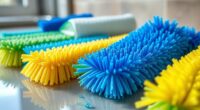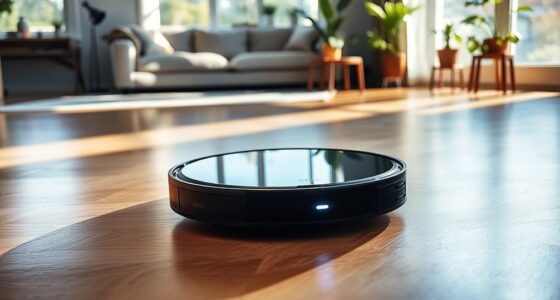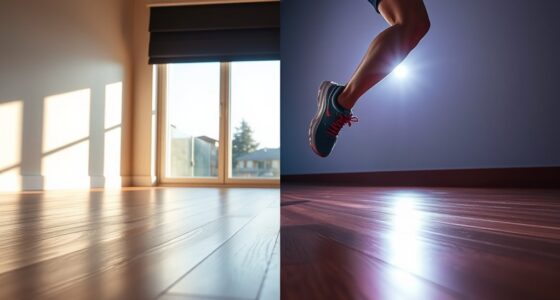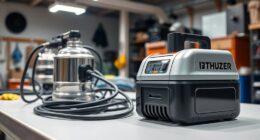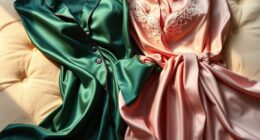When damp mopping sealed hardwood floors, use a mop that’s only slightly moist—think just damp, not dripping. Wring out excess water thoroughly to avoid pooling or streaks, and steer clear of over-wetting the surface. Proper damp mopping involves quick, controlled motions and immediate drying afterward. If you’re unsure about how wet is safe, learn more tips to protect your floors and keep them looking their best over time.
Key Takeaways
- Use a microfiber or cotton mop that is thoroughly wrung out to be damp, not wet.
- Ensure the mop is only slightly moist, avoiding drips or pooling of water on the floor.
- Mix cleaning solutions with water to create a dilute, gentle cleaning solution, reducing excess moisture.
- Immediately dry the floor with a microfiber cloth or towel after mopping to prevent water absorption.
- Regularly check that the mop remains damp, not soaked, to avoid over-wetting and potential damage.
Understanding Sealed Hardwood Floors and Their Durability

Sealed hardwood floors are designed to withstand daily wear and tear, making them a popular choice for many homeowners. The sealing process involves applying a protective finish that creates a barrier against moisture, stains, and scratches. This coating helps preserve the wood’s appearance and extends its lifespan. When properly maintained, sealed hardwood can handle regular cleaning routines, including sweeping and damp mopping. However, the durability depends on the quality of the sealant and how well it’s maintained over time. You should be aware that even sealed floors aren’t completely waterproof. They resist spills and moisture to a degree, but excessive water or improper cleaning methods can still cause damage. Understanding the limits of your sealed hardwood helps you care for it effectively and avoid unnecessary harm. Additionally, knowledge of the 16PF traits can provide insights into the best cleaning practices based on your personal tendencies and habits.
Why Water and Hardwood Floors Don’t Mix Well
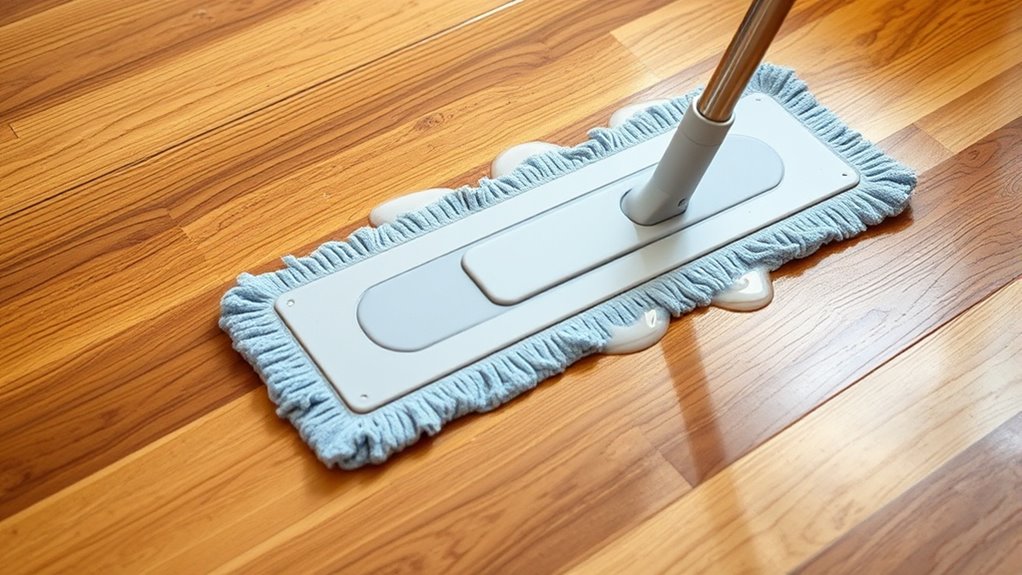
Water can seep into hardwood floors and cause swelling, warping, or staining that’s hard to fix. Even sealed surfaces aren’t completely waterproof, so over-wetting can still lead to damage. Using proper techniques helps prevent water penetration and keeps your floors looking their best. Understanding proper cleaning methods can further reduce the risk of water damage.
Water Penetration Risks
Even though hardwood floors are sealed to resist moisture, excess water can still cause serious damage. When water seeps past the seal, it can reach the wood beneath, leading to swelling, cupping, or warping. Standing water or repeatedly damp mops increase the risk of infiltration. Over time, this moisture can weaken the wood’s structure and promote mold growth in hidden areas. Even small amounts of water left on the surface can penetrate tiny cracks or imperfections in the seal. This makes it essential to avoid oversaturating your mop and to dry the floor thoroughly afterward. Remember, the seal isn’t foolproof—water that gets through can cause long-term damage that’s costly and difficult to repair. Researching proper cleaning methods and understanding how water interacts with sealed hardwood can help prevent costly repairs. Prevention is key to maintaining your hardwood’s integrity.
Damage Prevention Techniques
To effectively prevent damage to your hardwood floors, it’s essential to adopt proper cleaning techniques that minimize moisture exposure. Use a damp, not wet, mop and avoid standing water. Always wring out your mop thoroughly before cleaning. Additionally, clean spills immediately to prevent water from seeping into seams or cracks. Proper color accuracy in your cleaning tools and methods can also help maintain the natural appearance of your hardwood floors.
Here’s a quick reference:
| Do’s | Don’ts |
|---|---|
| Use a damp cloth or mop | Use excessive water during mopping |
| Wipe spills quickly | Let water sit on the surface |
| Use a microfiber or soft cloth | Use harsh or abrasive cleaners |
| Regularly sweep to remove debris | Use a soaking wet mop |
Following these tips helps preserve your hardwood’s integrity and appearance.
Signs Your Floor Is Too Wet During Mopping

If your floor starts to feel slick or sticky during mopping, it’s a clear sign you’re using too much liquid. Excess moisture can seep into the seams and damage the wood over time. To avoid this, watch for these signs:
Using too much liquid can make your hardwood floors slick and risk damage over time.
- The floor feels slippery underfoot, increasing the risk of slips.
- Water pools or leaves streaks that don’t dry quickly.
- You notice a dull or hazy film forming on the surface after mopping.
These indicators mean you’ve applied too much liquid. Using a damp mop rather than a wet one helps prevent water from penetrating the seal and damaging your hardwood. Keep your mopping light and quick, ensuring your floor stays clean without risking harm.
Preparing Your Mop and Cleaning Solution for Damp Mopping
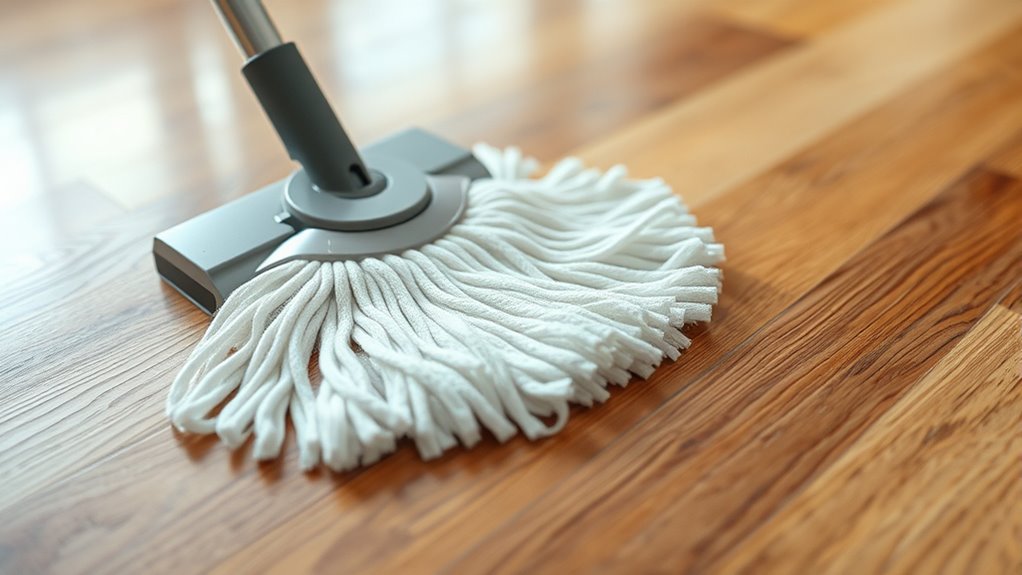
Before you start damp mopping, it’s important to prepare your mop and cleaning solution properly. Use a microfiber or cotton mop that absorbs water well. Wring out excess liquid so the mop feels damp, not soaked. For your cleaning solution, mix a small amount of gentle hardwood floor cleaner with water—about a few drops per gallon. This approach helps prevent water damage to your sealed hardwood floors and keeps them looking their best.
Step-by-Step Guide to Damp Mopping Safely
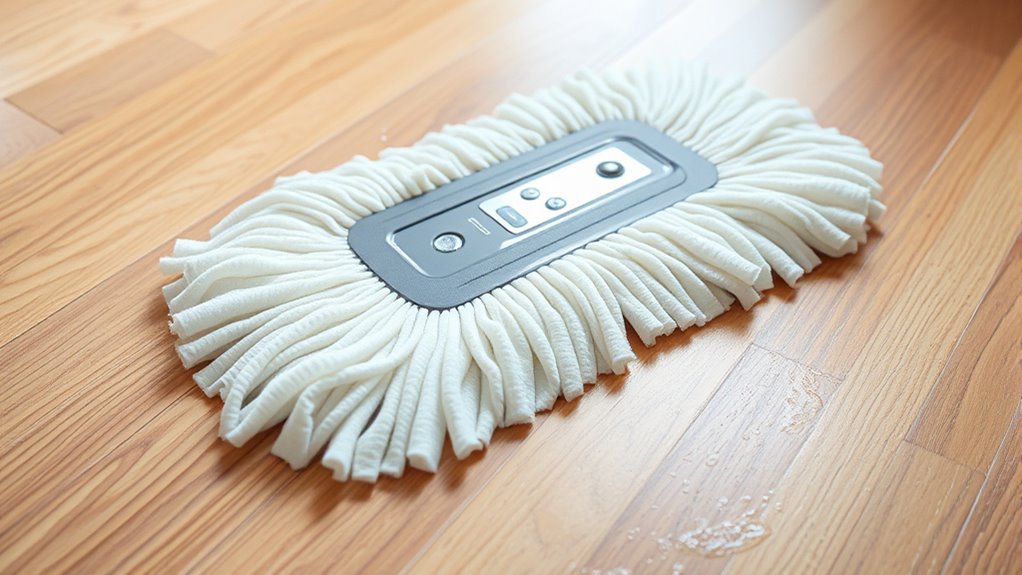
To damp mop your sealed hardwood safely, start by selecting the right mop that won’t scratch the surface. Make sure to wring out excess water thoroughly to prevent oversaturation, and dry the floor completely afterward to avoid damage. Following these steps guarantees your floors stay clean and well-preserved.
Choosing the Right Mop
Choosing the right mop is essential for safe and effective damp mopping of sealed hardwood floors. You want a tool that cleans well without soaking the surface. Consider these options:
- Microfiber mops: They trap dust and dirt efficiently and require less water.
- Cotton string mops: They absorb moisture well but need careful wringing.
- Flat mops: They glide smoothly and allow for controlled moisture levels.
Pick a mop with a lightweight design for easy maneuverability. Verify the mop head is removable and washable for hygiene and convenience. Avoid overly thick or plush mops that hold too much water, risking damage. The right mop helps you control moisture, making your damp mopping safer and more effective. Moisture control is a key factor in preventing damage to your hardwood floors during cleaning.
Proper Wringing Technique
Proper wringing is essential for damp mopping because excess water can damage your hardwood floor. To start, fill your bucket with clean water and dip your mop into it. Then, lift the mop and gently squeeze or twist the handle to remove excess water. Your goal is a damp, not soaked, mop. Avoid twisting too hard, which can damage the mop or cause uneven moisture. Check the mop’s surface; it should be moist but not dripping. If needed, wring it again to remove any remaining water. Always wring out the mop thoroughly before applying it to the floor. Proper wringing ensures effective cleaning while preventing excess moisture that could cause warping or damage to your hardwood. Regularly monitoring moisture level helps maintain the right dampness, preventing potential damage.
Effective Drying Methods
After damp mopping, it’s essential to dry your hardwood floor promptly to prevent water damage and warping. To do this effectively, follow these steps:
- Use a clean, dry microfiber cloth or towel to quickly absorb excess moisture.
- Turn on your ceiling fan or open windows to increase air circulation and speed up drying.
- Employ a soft, dry mop or microfiber pad to go over the surface, removing lingering dampness.
- Consider using a dehumidifier in the room to help reduce moisture levels and facilitate faster drying.
These methods help guarantee your hardwood dries evenly and thoroughly. If needed, you can also use a fan directed at the floor or a portable heater set on low to accelerate the process. Always avoid leaving wet areas unattended, as prolonged moisture can lead to damage.
Ideal Moisture Levels for Mopping Sealed Hardwood Floors
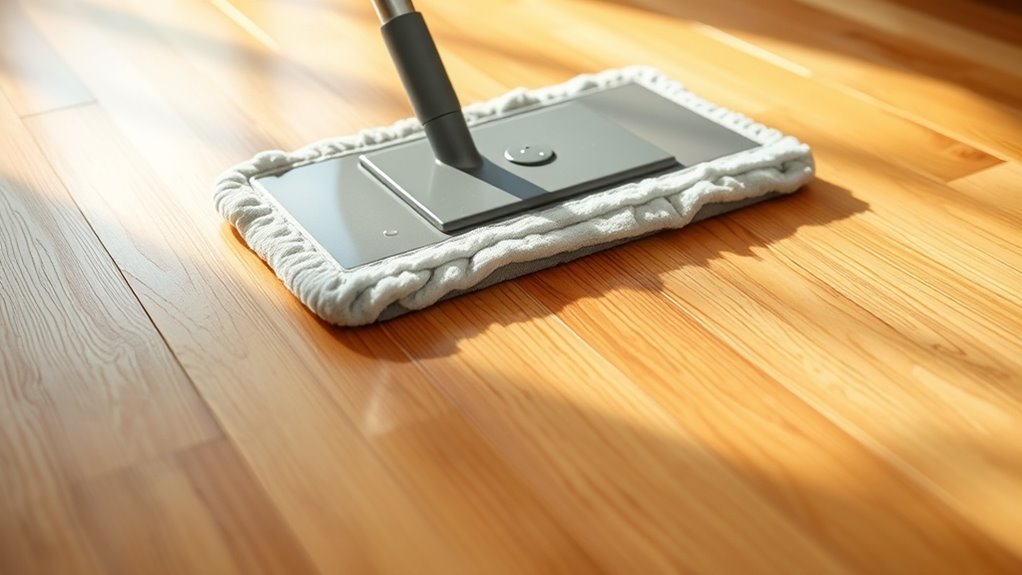
Maintaining the right moisture level during mopping is essential to protect your sealed hardwood floors from damage. Ideally, your mop should be damp, not soaked. Aim for a moisture level where the mop feels just slightly moist to the touch, with no excess water dripping out. Too much water can seep into seams and cause warping or swelling over time. Use a microfiber or terrycloth mop and wring it out thoroughly before cleaning. If you notice water spots or streaks, your mop might be too wet. Regularly check the mop’s moisture level during cleaning to prevent over-saturating the floor. Keeping the moisture minimal ensures effective cleaning without risking damage to your sealed hardwood surface.
Common Mistakes to Avoid When Damp Mopping
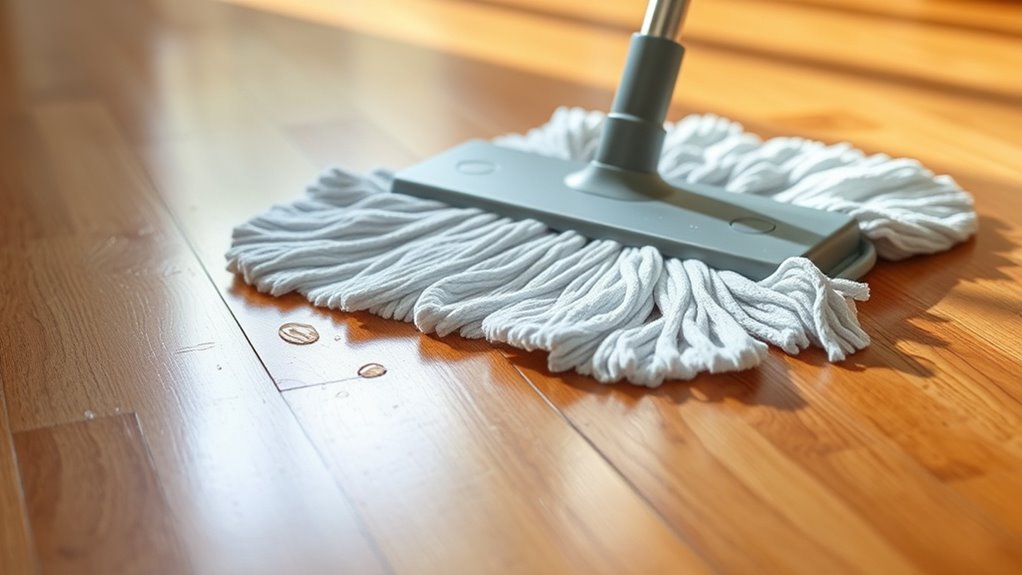
One common mistake to avoid when damp mopping is using a mop that’s too wet, which can lead to water seeping into seams and causing damage over time. To prevent this, pay attention to your mop’s moisture level. Here are three mistakes to watch out for:
- Using Excessively Wet Mops: Squeeze out as much water as possible to minimize excess moisture.
- Skipping Routine Rinsing: Dirty mops spread dirt and grit, scratching the finish.
- Over-mopping the Same Area: Repeatedly going over the same spot can push water into seams, risking damage.
Tips for Drying and Ventilating After Mopping

Proper drying and ventilation are key to preventing damage after damp mopping your sealed hardwood floor. To speed up drying, use fans or open windows to circulate air. Elevate furniture slightly to allow airflow underneath. Additionally, wipe up excess water immediately with a dry cloth to prevent moisture from seeping in. Incorporating vertical storage solutions can help keep your space organized and prevent clutter that may hinder proper airflow.
Alternatives to Damp Mopping for Deep Cleaning

If you want to avoid damp mopping, several effective deep cleaning alternatives can keep your sealed hardwood floors looking their best. First, dry dust mopping with a microfiber mop removes surface dirt without moisture. Second, vacuuming with a soft brush attachment lifts debris and prevents scratching. Third, occasional deep cleaning with a wood floor cleaner applied sparingly using a damp cloth or sponge helps disinfect without excess water. You can also use a steam mop designed specifically for sealed hardwood floors, but only if it produces minimal moisture and is approved by your floor’s manufacturer. These methods reduce the risk of water damage while ensuring your floors stay clean, shiny, and protected over time. Additionally, understanding your floor’s type of sealant can help you choose the safest cleaning methods.
Maintaining the Beauty of Your Hardwood Floors Over Time

To keep your hardwood floors looking their best over time, regular maintenance is essential. Start by sweeping or vacuuming daily to remove dirt and debris that can scratch the surface. Use a damp mop with a pH-neutral cleaner designed for hardwoods, avoiding excess water to prevent damage. Place mats at entryways to reduce dirt buildup and wear. Protect high-traffic areas with rugs or runners. Refinish your floors every few years to restore their shine and repair minor scratches. Avoid harsh chemicals, abrasive pads, and excessive moisture, which can dull or warp the surface. Maintain proper humidity levels to prevent wood from expanding or contracting. With consistent care, your floors will retain their beauty and durability for years to come.
Frequently Asked Questions
Can I Use a Steam Mop on Sealed Hardwood Floors?
You can use a steam mop on sealed hardwood floors, but do so carefully. Make sure the steam mop isn’t too hot or producing excessive moisture, as too much steam can damage the sealant or cause warping. Keep the mop moving quickly and avoid lingering in one spot. Use the lowest steam setting, and always check your floor manufacturer’s recommendations to prevent any potential damage.
How Often Should I Damp Mop My Hardwood Floors?
You should damp mop your hardwood floors once a week or as needed to keep them clean and free of dirt. Always use a well-wrung mop to avoid excess moisture, which can damage the wood. If you notice spills or sticky spots, clean them immediately with a damp cloth. Regularly maintaining your floors with a damp mop helps preserve their appearance and longevity without risking water damage.
What Types of Cleaning Solutions Are Safe for Sealed Hardwood?
Imagine your hardwood floor as a delicate canvas—you want to clean it without soaking or damaging. Stick to gentle solutions like a few drops of dish soap mixed with water or a pH-neutral hardwood floor cleaner. Avoid harsh chemicals, vinegar, or ammonia, which can harm the finish. Always use a damp, not soaking, mop to preserve the wood’s beauty and integrity while keeping it spotless.
Is It Better to Use a Microfiber or Cotton Mop for Damp Cleaning?
You should opt for a microfiber mop for damp cleaning because it absorbs less water and distributes moisture evenly. Microfiber mops are gentle on sealed hardwood surfaces, reducing the risk of excess water seeping into seams or gaps. Cotton mops tend to hold more water and may leave your floor overly wet, increasing potential damage. Using a microfiber mop guarantees you clean effectively without risking water damage or warping.
How Do I Prevent Streaks After Damp Mopping?
Think of it as channeling your inner Sherlock—streaks vanish when you rinse your mop well and use a clean, slightly damp cloth. Always mop in the direction of the wood grain, avoiding excess water. After mopping, dry the surface with a soft towel or microfiber cloth to prevent residue. Regularly switch out your cleaning water and avoid overwetting, ensuring your hardwood stays streak-free and gleaming.
Conclusion
To keep your sealed hardwood floors looking their best, avoid using excessive water during damp mopping. Remember, even a small amount of excess moisture can cause warping or damage over time. Did you know that hardwood floors can be affected by just 1-2% moisture increase? By following safe damp mopping practices, you guarantee your floors stay beautiful and durable for years to come. Stay mindful, and your floors will thank you!

